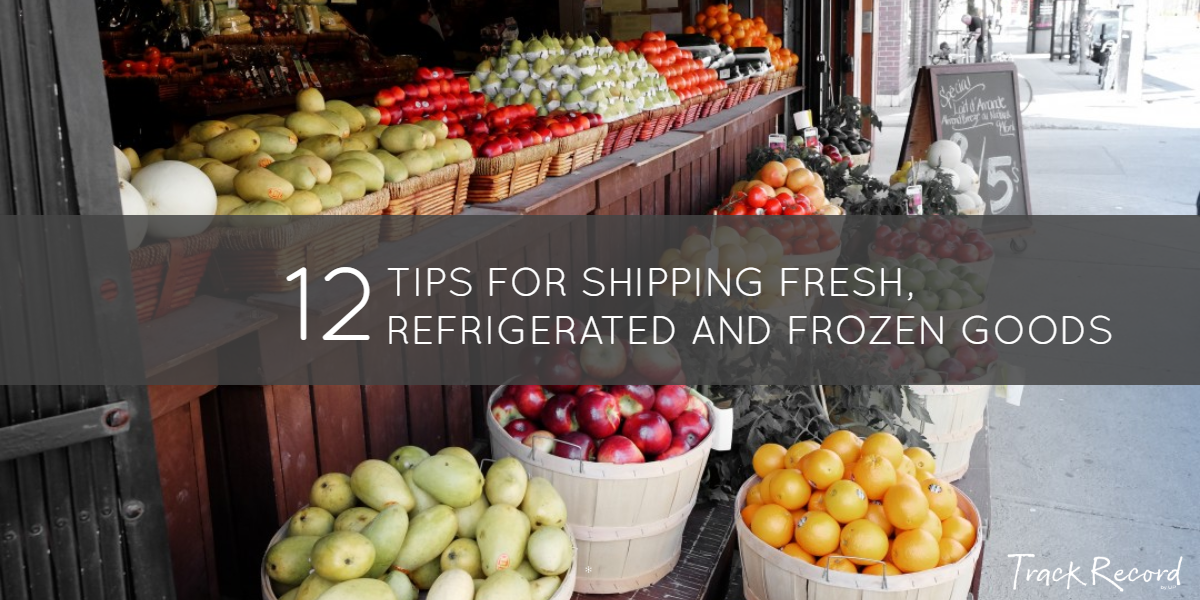If you ship fresh, frozen or refrigerated goods, you know food doesn’t just magically appear on supermarket shelves. Rather, a lot of forethought goes into the shipping process to be sure those products arrive intact and ready to eat. Are you taking all of the proper steps to ensure your products arrive safely? And are you using the right mode to get them there? Let’s dig in and find out…
1. Select the Best Shipping Mode
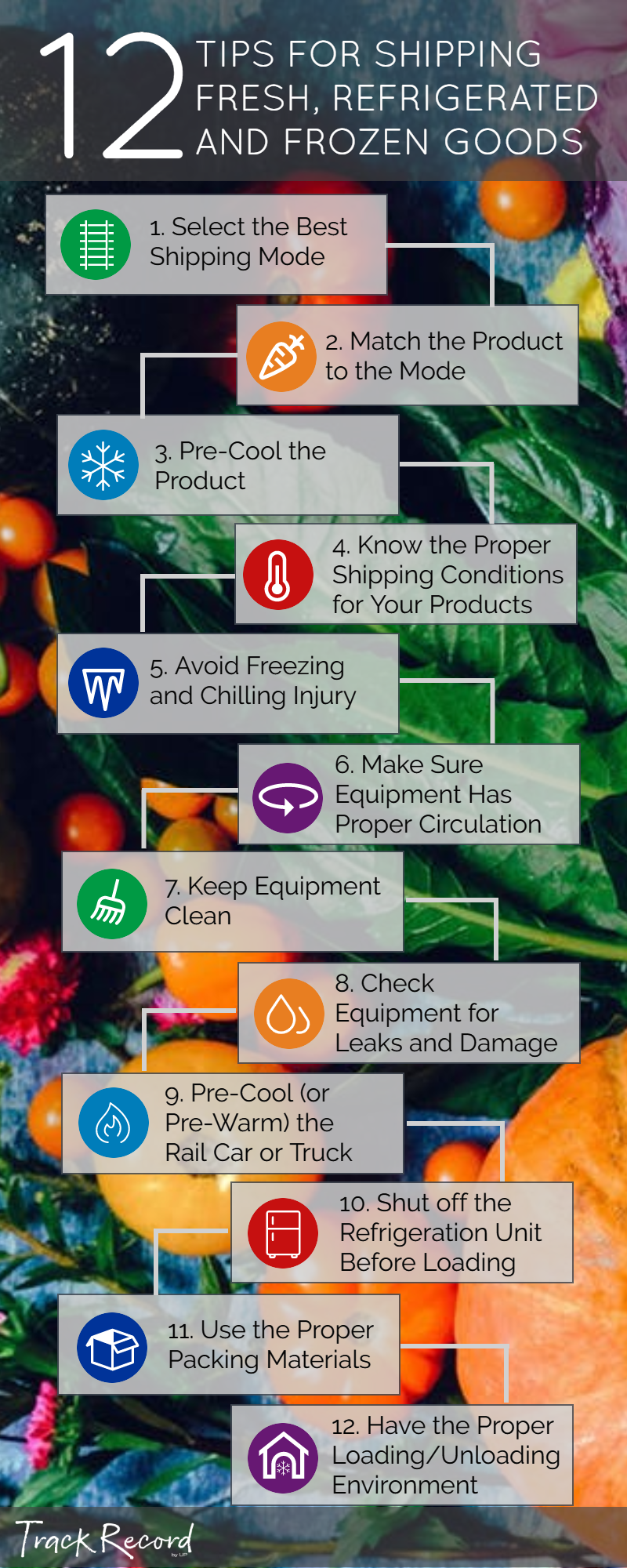
Download a printer-friendly version of the infographic.
Fresh, refrigerated and frozen goods can ship by both truck and rail. Choosing the most appropriate mode will likely depend on these factors:
- Price — Rail tends to be more economical than truck, especially over long distances.
- Product Type and Transit Time — Some products can handle long trips, while others are more perishable and must ship quickly, so understanding the transit times related to each mode is important (more on this in a moment).
- Quantity — Rail is ideal for large quantities, as you can ship roughly four trucks’ worth in a single rail car. If you’re shipping smaller quantities, both truck and rail can accommodate your shipment, even if it is a less-than-truckload (LTL) quantity.
2. Match the Product to the Mode
When it comes to shipping frozen goods, both trucks and trains can keep them ice cold thanks to refrigerated trailers and cars (better known as “reefers”). Reefers can also maintain the temperature of refrigerated foods during shipping, but when it comes to produce, not every fruit and veggie can handle longer transit times.
Just as some types of produce last longer in your refrigerator than others, the same goes for which ones tend to be heartier or more fragile in transit. In other words, you’ll want to choose a mode with a shorter transit time for anything that spoils quickly, like celery, blueberries and bananas.
Potatoes, onions, carrots and apples, on the other hand, tend to have a longer shelf life and can handle lengthier trips. These hearty products are prime candidates for shipping by rail — and many produce shippers choose rail for its economic and environmental benefits.
If you’re not sure whether your produce can ride the rails, contact the railroad — they have experts on staff who are happy to lend their guidance on how to safely deliver your products.
3. Pre-Cool the Product
Pre-cooling is any cooling of the product that happens before shipping begins. Why pre-cool? When produce is harvested from the fields, it retains heat from the sun. Pre-cooling, which should happen as soon as possible after harvest, removes field heat and helps fruits and veggies maintain a fresh appearance, prevent decay and extend market life.
4. Know the Proper Shipping Conditions for Your Products
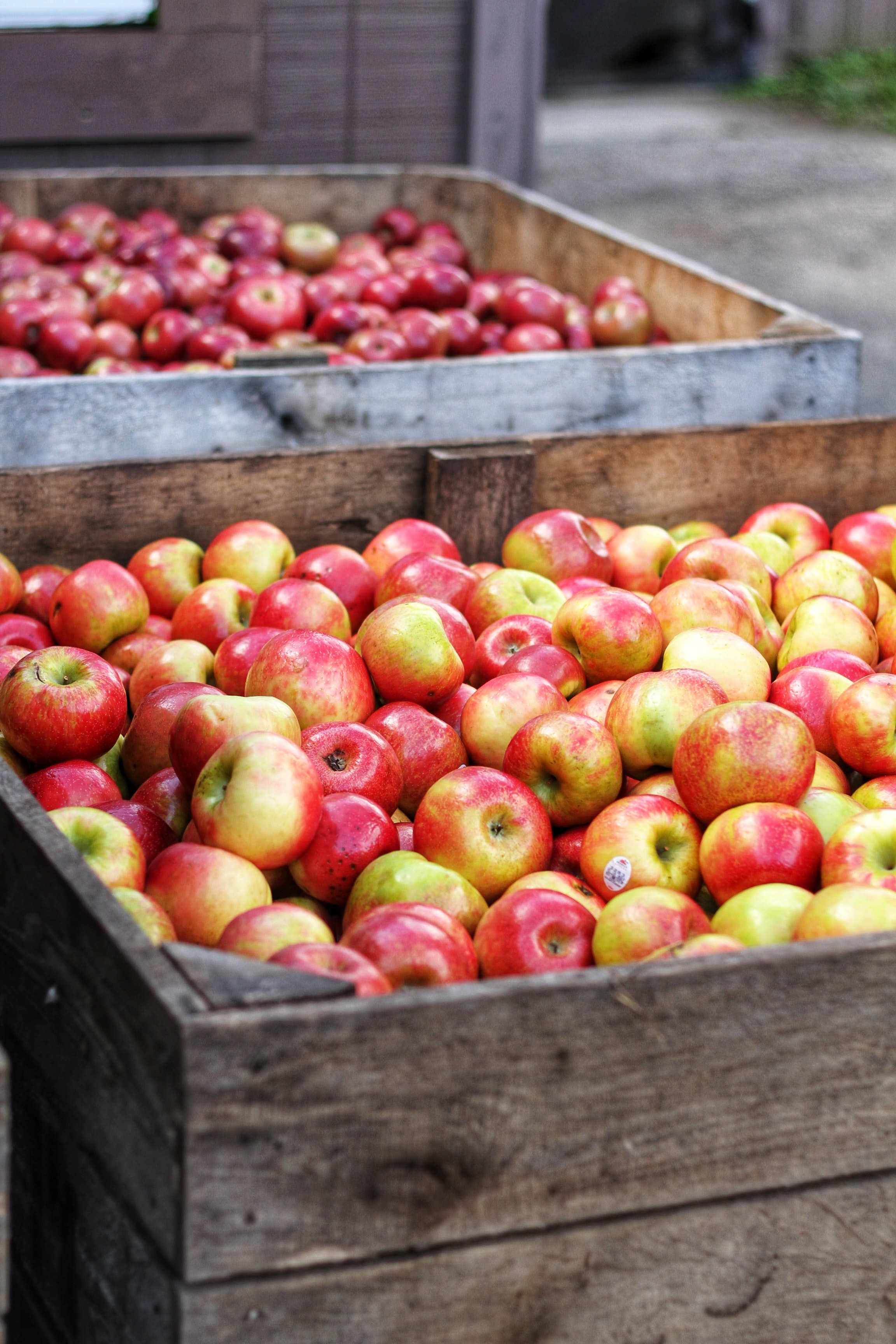
During shipping, each product will have its own requirements for temperature and humidity. Knowing the ranges (and ensuring products stay within them between origin and destination) is key to their safe arrival. Some examples of desired transit temperature and relative humidity for produce include:
- Apples — Most varieties: 30° to 32°F, 90 to 95 percent humidity
- Carrots — 32°F, 98 to 100 percent humidity
- Onions — 32°-45°F (storage varieties), 45°-60°F (fresh varieties), 65 to 70 percent humidity
- Potatoes — 40° to 60°F (depending on use and early or late crop), 90 percent humidity
The USDA offers a comprehensive list of temperatures and proper loading procedures for fruits, vegetables, canned foods, dairy products, meats, seafood, poultry, eggs and frozen foods here.
5. Avoid Freezing and Chilling Injury

Even though we think of cooling when it comes to shipping food, it’s also important to avoid freezing and chilling injury, which happens to products when outside temperatures are lower than 32 degrees F. For instance, freezing can cause meat to darken, eggs to crack and cheeses to change texture. In these situations, products may need to be warmed rather than cooled.
The potential for freezing damage varies depending on the product. The most common freezing losses occur with fruits and vegetables like apples, celery and lettuce. Other produce, like beets and cabbage, can freeze and thaw several times without damage.
6. Make Sure Equipment Has Proper Circulation
Without proper air circulation, products won’t maintain their temperature and refrigeration is basically rendered meaningless. That’s because circulation carries heat from the walls, floor and ceiling of a reefer as well as from the products inside, to the refrigeration unit where it can be removed. Air circulation also ensures temperatures are uniform throughout the load — otherwise some products may arrive too cold and others too warm (both of which can result in damage).
While circulation is important, you’ll want to load boxes of frozen goods tightly together so that air circulates around the perimeter and there is as little contact as possible with the (warmer) floors and walls.
7. Keep Equipment Clean
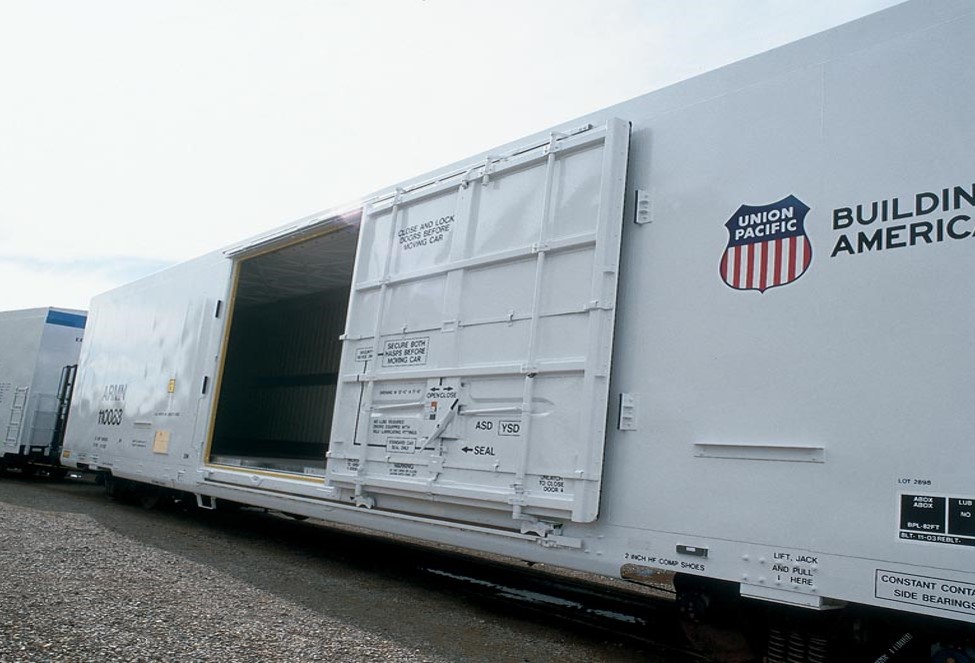
It’s important to keep equipment clean between loads, as it prevents bacterial, chemical and odor contamination. That means removing debris, washing or sweeping floors, and ensuring drains are clean. To remove odors, the USDA recommends placing a freshly opened can of coffee grounds in the space to absorb odors, or even sprinkling them on the ground, then sweeping them up before loading.
8. Check Equipment for Leaks and Damage
Make sure all seals are maintained to block air leaks, which can prevent proper air temperature. Likewise, broken seams and damaged walls can allow moisture to damage insulation and reduce its effectiveness and in turn, damage the product.
After loading, open and close the trailer or rail car door to ensure the door seal is tight, and make sure the container is sealed tight with no leaks or floor/ceiling holes.
9. Pre-Cool (or Pre-Warm) the Rail Car or Truck
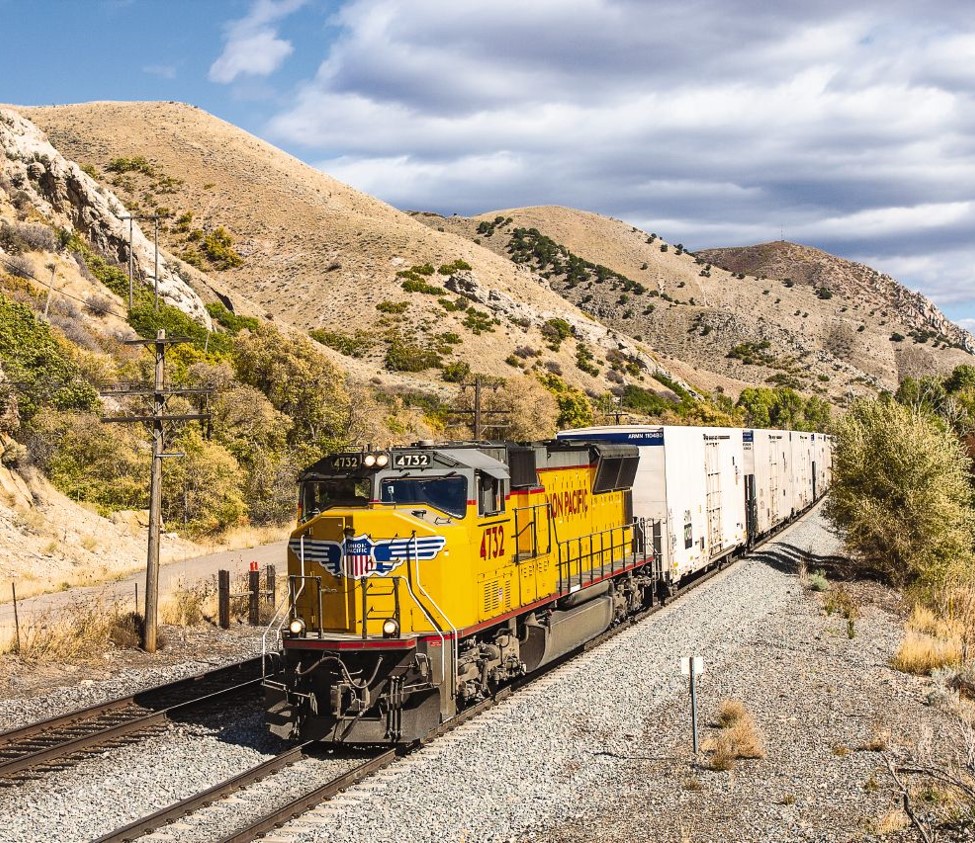
One to two hours before loading, set the thermostat to the desired temperature, close the doors and run refrigeration until it cools to the appropriate temperature. In hot temperatures, this may take more than two hours. Pre-cooling helps keep the refrigeration system from being overtaxed and helps keep products at the desired temperature. In cold temperatures, pre-warming (a similar process to pre-cooling, but with heat instead of refrigeration) helps prevent freezing and chilling damage.
10. Shut off the Refrigeration Unit Before Loading
In general, fiberboard boxes are usually the safest choice for packing fresh, frozen and refrigerated foods. While hearty produce like potatoes and onions can ship in bags or in bulk, those packing methods may make the products susceptible to bruising. To provide protection, paper and plastic foam pads can provide cushioning between bags, and fiberboard slipsheets can provide cushioning between the product and the floor. Any material you use to protect products should be perforated to promote proper air circulation, and products like straw should be avoided, as they can block air flow beneath the load.
When loading, don’t forget to properly block and brace (i.e., secure) your products and ensure the weight is evenly distributed throughout the trailer or rail car. Be sure to allow for at least 12 inches of space between your products and the ceiling. This will help to maintain airflow and the center of gravity.
12. Ensure You Have the Proper Loading and Unloading Environment
Yes, both trucks and trains have reefers to keep products at the perfect temps during transit. But don’t forget that there are two other key pieces to the shipping puzzle: loading and unloading. For instance, do the loading docks have curtains at entry points to maintain the temperature in the warehouse as forklifts go in and out?
Not every fresh or frozen product will need to be temperature controlled at origin – some sheds are open and exposed to the elements, and that’s okay for certain products. But, especially if you’re shipping to a warm climate — and especially if you’re shipping something like cheese or frozen foods — you’ll want to make sure the destination is temperature controlled to maintain the integrity of your product at the end of its journey.
Are You Ready to Optimize Your Food and Beverage Shipments?
If you have questions about how to properly ship food or would like a little more advice on how to optimize your cold chain, get in touch! We’d be happy to help.
Or, check out these tips for refrigerated shipments.
Related Articles

